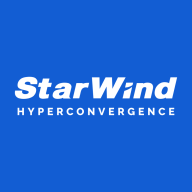![NetApp HCI [EOL] Logo](https://images.peerspot.com/image/upload/c_scale,dpr_3.0,f_auto,q_100,w_64/d0l9qfqabzdxvnpfjyza8ogvpueo.jpg?_a=BACAGSDL)

Find out what your peers are saying about Dell Technologies, Broadcom, StarWind and others in HCI.

| Company Size | Count |
|---|---|
| Small Business | 8 |
| Midsize Enterprise | 9 |
| Large Enterprise | 19 |
| Company Size | Count |
|---|---|
| Small Business | 50 |
| Midsize Enterprise | 22 |
| Large Enterprise | 8 |
NetApp HCI is the only true enterprise-scale hyper converged cloud infrastructure. NetApp HCI comes in a 2 RU chassis with 4 node expansion slots.
For SMB, ROBO and Enterprises, who look to bring in quick deployment and operation simplicity to virtualization workloads and reduce related expenses, our solution is StarWind HyperConverged Appliance (HCA). It unifies commodity servers, disks and flash, hypervisor of choice, StarWind Virtual SAN, Microsoft Storage Spaces Direct or VMware Virtual SAN and associated software into a single manageable layer. The HCA supports scale-up by adding disks and flash, and scale-out by adding extra nodes.
StarWind HyperConverged Appliance consists of StarWind Virtual SAN, Microsoft Storage Spaces Direct or VMware Virtual SAN “Ready Nodes”, targeting those, who are building their virtualization infrastructure from scratch. In case there is an existing set of servers, we offer a “software only version”, which is essentially our years proven StarWind Virtual SAN. Basically, it’s the fuel powering StarWind HCA.
We monitor all HCI reviews to prevent fraudulent reviews and keep review quality high. We do not post reviews by company employees or direct competitors. We validate each review for authenticity via cross-reference with LinkedIn, and personal follow-up with the reviewer when necessary.